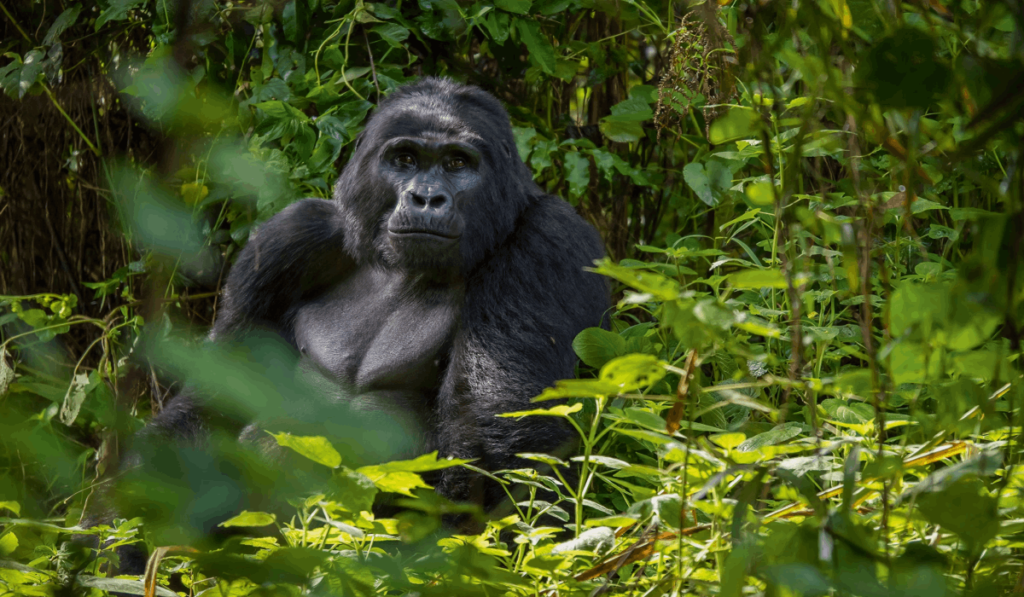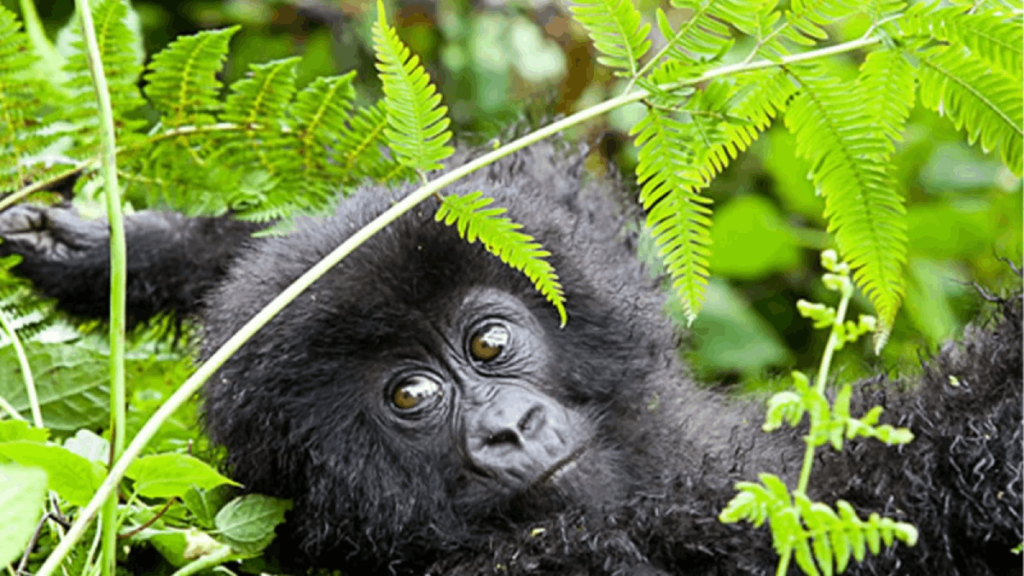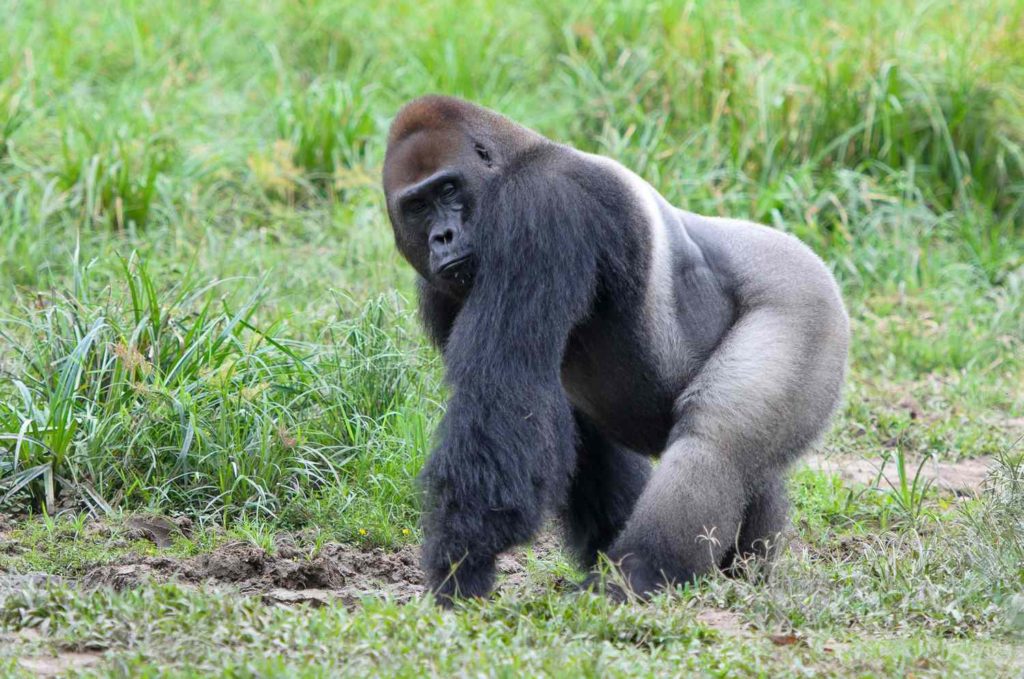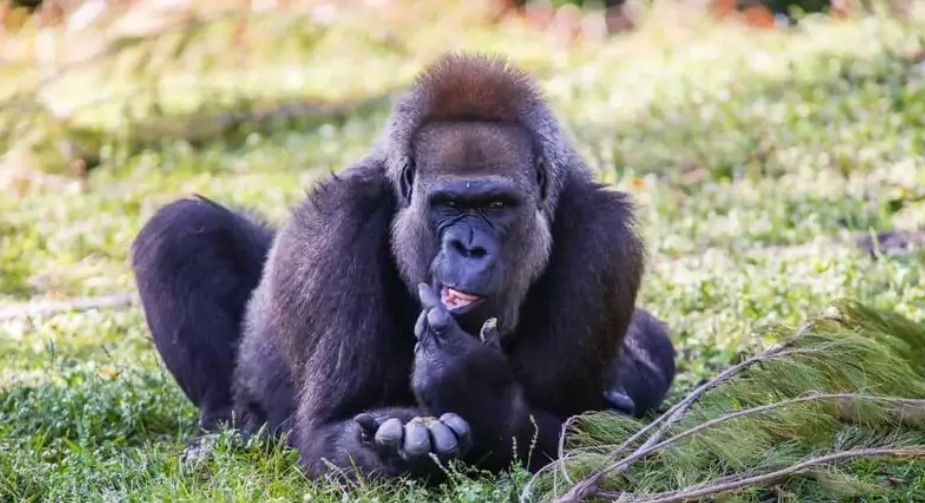Gorilla species found in Africa
Gorilla species found in Africa : After chimpanzees and bonobos, gorillas are the largest of the great apes and among the closest cousins of humans. Humans and gorillas have 98% of the same genetic makeup. Gorillas exhibit a wide range of human-like actions and emotions, including grief and laughter. Only a small portion of Africa’s tropical forests, swamps, marshes, highlands, and mountains are home to wild gorillas.

Strong, muscular arms, broad chests, big nostrils, and black or brownish hair characterize gorillas as formidable animals. All body save face, hands, feet, and chest (ancient silverbacks) is covered with hair. Walking gorillas Gorilla species typically stand on all four legs, but they are also capable of standing straight, particularly when showing dominance or munching on tree bark. Because of the silver or gray hairs on their backs, adult male gorillas are known as silverbacks. In the wild, silverbacks can weigh anything from 135 to 220 kilos, making them larger than females. Because they have less area to exercise or receive less exercise, animals kept in confinement may become heavier and fatter. Adult gorillas try to avoid climbing trees because of their weight. Most of the time, the young climb trees and spend their nights on their short branches.
Living in groups, gorillas are headed by a dominant silverback. In certain gorilla subspecies, it is uncommon for two related silverbacks to lead a troop, but it does happen occasionally. Between four and thirty gorillas, who can live up to 35 years in the wild (45 in captivity), can make up a gorilla group or family. Younger men, minors, women, and their infants may be in the group. A gorilla group’s ability to remain stable is solely dependent on the relationship between the females and the dominant silverback. In gorillas, the female often initiates mating as soon as she becomes fertile. When a young girl reaches sexual maturity, she always leaves the group to associate with other girls or lone boys. The purpose of this movement is to prevent competition for the dominant Silverback’s attention and inbreeding. A mature male may remain with his birth group, but most of the time, he is forced to leave by the dominant silverback to go off on his own or associate with other single males. They will attempt to kidnap ladies from stable groups in order to fill their lonely lives. If a male is successful in remaining with his family, he will wait to succeed his aging father while keeping a low profile and mating with a few of the females.
species of gorillasGorillas are wiser, more persistent, calmer, and more peaceful than chimpanzees, despite the belief that chimps are the more intelligent primate. Compared to chimpanzees, their communities are significantly more stable and their members are extremely loyal to one another. Chimpanzees exhibit higher levels of aggression, and the dominant male must exert significant effort to maintain group discipline. Despite their cool-headed exterior, gorillas can roar or growl very loudly in response to danger. In an effort to keep the family safe, the silverback will use violent displays, roars, tearing at plants, sideways sprinting, slapping the ground, or chest beating to frighten away any intruders. Before retreating, the silverback will also seem to assault the intruder.
Primarily, gorillas consume leaves, fruits, and shoots. Although they primarily eat plants, they will occasionally catch ants or other insects. To feel full, gorillas must consume a large amount of vegetation each day. They might therefore go several kilometers in separate searches for food. The lack of territoriality in gorilla groups can likely be attributed to their abundant lifestyle in densely forested areas. Even though they may inhabit the same area, gorilla groups tend to stay apart. Only western lowland gorillas have been observed engaging in group mixing and cooperative feeding. The gang will construct makeshift nets in the afternoon after eating for the most of the morning. Feeding continues till late in the afternoon following the midday sleep. After that, the group will construct comfortable-looking night nests by bending branches of nearby trees and plants. Every night, fresh nests are constructed, sometimes atop small trees and sometimes on the ground. While young silverbacks share nests with their moms, the species usually always sleeps on the ground.
Male and female gorillas attain sexual maturity at roughly 15 years of age, with females reaching this stage at around 10. Women typically give birth after a nine-month gestation period, every four to five years. One of the factors that makes gorillas an endangered species is their poor rate of reproduction. Although the female typically gives birth to a single child, twins are frequently born. A newborn, weighing two kilograms at birth, must spend three months being held in the mother’s arm before it develops the strength necessary to ride on her back.
Humans pose the biggest threat to gorilla populations. Because of illicit logging and deforestation, humans are destroying gorilla habitats. In addition, snares trap other forest species, such as gigantic forest pigs, and pose a concern to humans through infections, animal trafficking, poaching, and unintentional deaths. Gorillas may readily Since gorilla subspecies do not run away like chimpanzees do, they are hunted down for their meat. Gorillas will actually fight to the death to protect their offspring. Poachers and animal traffickers might have to eliminate the entire group in order to capture a baby gorilla. Because it can aid in the transmission of illnesses like Ebola to both humans and other gorilla communities, the trade in wild gorillas is risky. It was projected in 2003 that the Ebola virus had killed one-third of the lowland gorilla populations in the western world. How do gorillas get affected by logging? The primates are exposed, to start with. Because most of Africa’s forests were so large, gorillas could live in peace and harmony with nature. As more trees were taken down for farming and lumber, gorilla groups began to interact with people more frequently. Due to their inability to communicate with other gorilla groups, some gorilla populations that were previously isolated in areas of forest that were bordered by farmlands for humans are now experiencing inbreeding. Human diseases are highly contagious among gorillas. Scabies, tuberculosis, and the common cold can all be fatal for an entire gorilla family.

To prevent the extinction of this magnificent animals, a number of zoos, individuals, and international conservation groups have taken action. In Africa, gorilla tours have contributed to increasing public awareness of the gorillas’ predicament and bringing in the money required for study and protection. National parks have benefited from the backing of groups like the World Wide Fund for Nature (WWF), which has trained staff members and provided cutting-edge tracking technology. Similar groups have provided funding for initiatives aimed at stopping illegal logging, pet trade, and poaching. To determine their numbers and dispersion, the yearly gorilla censuses pool resources from a number of gorilla conservation organizations across the globe. Additionally, people can donate to groups like Gorilla Doctors and the Dian Fossey Gorilla Fund International or sponsor a gorilla.
Note: The absence of the rule of law, civil upheaval, corruption, and lax implementation of established laws have hindered the efforts of wildlife conservation agencies. Bush meat poachers, eaters, and dealers frequently receive short penalties or are never caught at all.
Gorilla Types
The Two Types of Gorillas
The Eastern gorilla and the Western gorilla are the two species of gorillas (Gorilla Gorilla). The most common species is the western gorilla. Compared to Eastern gorillas, they have a lighter skin tone and a different nose structure. The Cross River Gorilla (G. gorilla diehli) and the Western Lowland Gorilla (G. gorilla gorilla) are the two subspecies of Western gorillas. The mountain gorillas (G. beringei beringei) and the eastern lowland gorillas (G. beringei graueri) are the two subspecies of the eastern gorilla (G. beringei). These days, the Grauer’s gorilla is the common name for the Eastern lowland gorilla. The Democratic Republic of the Congo, Rwanda, and Uganda are home to the largest apes in the world, the eastern gorillas.

The Four Subspecies of Gorillas
Gorillas in the Western Lowlands (G. gorilla gorilla)
The lowland forests of central and west Africa—Angola, Equatorial Guinea, Central African Republic, Cameroon, Gabon, Democratic Republic of the Congo, the Republic of the Congo, and Gabon—are home to the Western Lowland Gorilla. Out of the four gorilla subspecies, they are the most numerous and the lowest in size. Because the main species of gorillas inhabit some of Africa’s biggest and densest forests, it is challenging to determine their exact population size. More than 350,000 are thought to still be in the wild. In addition to being the most frequently observed species in zoos, western lowland gorillas are distinguished from the two subspecies of eastern gorillas by their grayish/reddish fur. They have been noted to be more receptive to feeding and interacting with other groups. Despite being the most populous gorilla subspecies, it is estimated that their total population has decreased by 60% over the past 25 years. Humans and the Ebola virus, which in 2003 killed off more than 30% of their total population, pose the biggest threat to them. In zoos or national parks in west and central Africa, one can witness the western gorilla.

Gorillas of the Cross River (G. gorilla diehli)
The IUCN classed the Cross River Gorilla as severely endangered in their 2006 List, and they were recognized as a separate subspecies in 2000. In Cameroon and Nigeria, a 3,000 square mile area of forested forests and highlands is home to the Cross River gorillas. Taking into account the distribution of gorillas, they reside in the most northern/western region of Africa. Cross River Gorillas can reach weights of up to 440 pounds. Gorilla species in Africa can reach lengths of up to five feet. There are less than 350 of these gorilla subspecies left in the wild, making them the most vulnerable. Because they live in a confined area and interact with people more frequently than other gorilla species, Cross River gorillas are especially vulnerable to extinction. Their frequent interactions with humans have made them more elusive, aggressive, and challenging to study. Poaching, habitat loss, and genetic diversity loss pose the biggest threats to them. Because of illicit logging, some gorilla communities are now secluded on mountain and forest islands. To make sure they are not exterminated, the governments of Cameroon, Nigeria, and international wildlife conservation organizations have moved quickly.

The WWF has collaborated with the local governments to assist in the reforestation of areas where farming and illicit logging have split off gorilla families. The significance of primates to the ecology and future generations has also been brought up with the local communities that are near the gorilla habitats. There is currently no gorilla tourism available for the Cross River gorillas, and they are not housed in zoos.
The Eastern Lowland gorilla, sometimes known as the Grauer’s gorilla (G. beringei graueri), is a subspecies of gorilla.Eastern Democratic Republic of the Congo is home to eastern lowland gorillas. They can be found in the Odzala-Kokoua National Park, Maiko National Park, Kahuzi-Biega National Parks, and the vicinity of the Itombwe Massif. Of all the gorilla subspecies, the Graeur’s gorilla is the largest. Its hands are larger, its nose is short, and its body is stocky. They have black coats similar to those of mountain gorillas, although their head and body hair are shorter. Out of the three gorilla subspecies, they are the third most critically endangered species. The majority of the dangers are caused by habitat loss and hunting. In just the previous 20 years, their home range has decreased from 81,000 square miles to just 5,600 square miles. There are currently 7,500 Eastern lowland gorillas in the wild. Read more about hiking with gorillas in the eastern lowlands of the Congo.
The moutain gorillas (G. beringei beringei)
One of the two subspecies of Eastern gorillas is the mountain gorilla. Only the Virunga Mountain regions of Uganda, Rwanda, and the Democratic Republic of the Congo are home to mountain gorillas. Subspecies of GorillasThey typically reside in forests at higher elevations (8,000 to 12,000 feet) and on mountain slopes, and they are not as heavy as the Eastern Lowland Gorilla. Mountain gorillas are distinguished by their lengthy, thick hair and fur. Their heavy coat shields them from the chilly mountainside weather. Out of the four gorilla subspecies, mountain gorillas are the second most endangered. Only in the Congo’s Senkwekwe Gorilla Orphanage or in the wild can one observe them. Approximately 1,000 of them are still in the wild, according to 2018 census data. Due to ongoing human encroachment on forests and mountain slopes, mountain gorillas are also under risk of habitat destruction. Some are compelled to relocate farther up the chilly mountainside, which may be hazardous to their health. You can learn more by reading about facts about mountain gorillas or where to see them.



